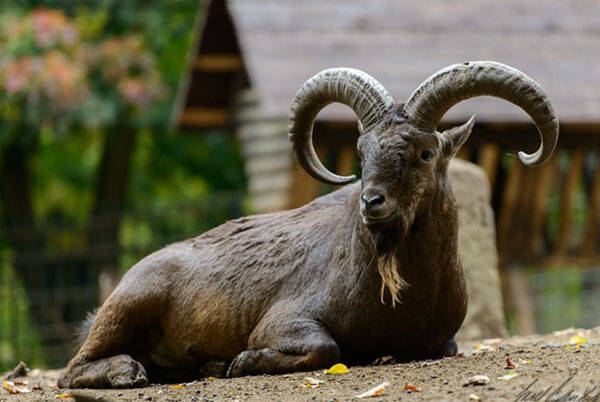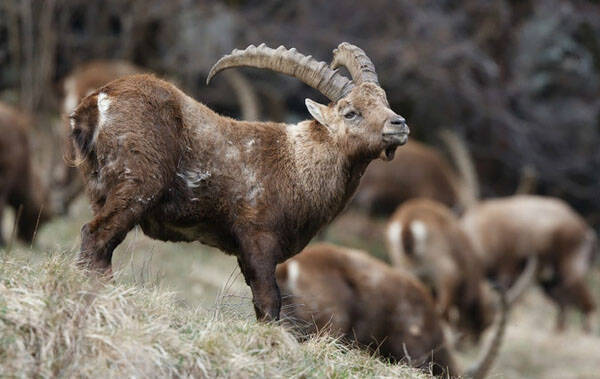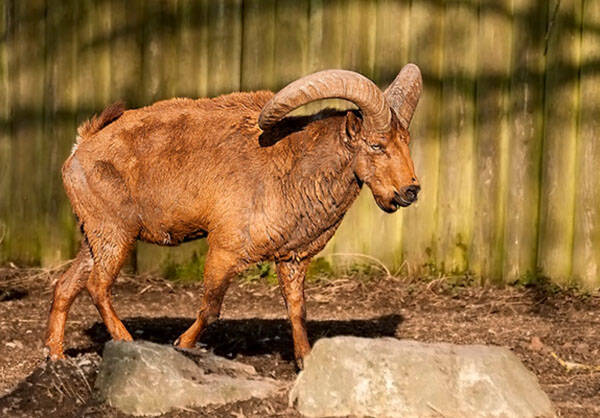Capra cylindricornis
IUCN
LCBasic Information
Scientific classification
- name:Capra cylindricornis
- Scientific Name:Capra cylindricornis
- Outline:Ungulata
- Family:Artiodactyla Bovidae Capra
Vital signs
- length:138-190cm
- Weight:56-140kg
- lifetime:About 12 years
Feature
The body is stout, the legs are short, and the beard is most noticeable in winter.
Distribution and Habitat
Distributed in Azerbaijan, Georgia and Russia.
The East Caucasian ibex is endemic to the central and eastern Greater Caucasus, along the borders of Russia, Georgia and Azerbaijan, at altitudes of 800-4000 m. Its range on the northern slopes begins near the source of the Baksan river east of Mount Elbrus (about 43º10'N, 42º30'E), or slightly eastwards, at the source of the Bezengi river (43º03'N, 43º01'E), roughly corresponding to the source of the Inguri river on the southern slopes of Georgia, and extends eastwards for about 500 km along the two slopes of the Greater Caucasus to the eastern tributaries of the Babadagh mountain massif (40º57'N, 48º29'E). Due to the peculiarities of the terrain, the distribution range of this species on the northern slopes is much wider than on the southern slopes. The distribution is more or less continuous, mainly in the easternmost part of the Azerbaijan Mountains. Possible geographical barriers are major river valley
Appearance
The East Caucasian ibex shows significant sexual dimorphism in body size, fur color, and horn development. Females are 138 cm long, 85 cm tall at the shoulder, and weigh 56 kg. Males are 190 cm long, 104 cm tall at the shoulder, and weigh 140 kg. The tail length of both sexes is 11-15 cm. The species has a stocky body and short legs. Like most goats, males also have beards, which are most noticeable when these animals are in winter. Unlike other goats, the skull of the East Caucasian ibex does not have a bump on the forehead below the horns. The horn base is cylindrical, and the horns curve upward and outward from the forehead, then curl slightly downward and inward at the tip. Female horns are 20-22 cm long, while male horns are 70-90 cm long.
The fur of males changes with the seasons, from a lighter chestnut brown underparts in winter to a lighter rusty brown overall color in summer. The fur of females, juveniles, and yearlings is the same year-round.
Details
Eastern Caucasian ibex (scientific name: Capra cylindricornis) English Eastern Tur, East Caucasian Tur, Spanish Tur oriental, Russian Bосточнокавказский тур, Дагестанский тур, no subspecies.

The coat of male East Caucasian ibex is brown in winter, which helps to distinguish them from males of other populations such as West Caucasian ibex, which are grayish yellow in winter during the year. The ibex is also similar to the East Caucasian ibex. These animals have similar colored coats and short beards, but can be easily distinguished from the East Caucasian ibex by the difference in their horns. The West Caucasian ibex is smaller and weighs less than the East Caucasian ibex. The East Caucasian ibex has much shorter beards, unlike other species of the family Ovis. They also lack the stripes on their front legs that are typical of ibex, Nubian ibex, and wild goats.
The East Caucasian ibex has seasonal migrations, during which they go up and down between 1500-2000 meters above sea level. They climb the mountain slopes after the snowfall in March and descend to the lower slopes in August. Males are usually solitary and live at higher altitudes and in more open areas than females. Females prefer lowland forest areas. The home range of male East Caucasian ibex overlaps with that of females, but males have a strong sense of territory with other males during the breeding season. Females form loose groups of about a dozen. The range of female groups is 4-6 square kilometers. Males have a larger range. East Caucasian ibex are a hierarchical social animal, with adult males dominating young males during the estrus period. Young males dominate females year-round, while females dominate young ibex under 1 year old.
East Caucasian ibex have three basic social units. Females form groups with young ibex, young males gather in groups on their own, and adult males usually act alone. Males only stay with females during the estrus season. Group size is usually around 10, but group size varies with precipitation. In the summer, feeding is usually done in the evening, night, and early morning, with resting in sheltered areas during the heat of the day. In the winter, the herd stays in open pastures all day to graze and rest.

The East Caucasian ibex has a variety of vocalizations. They have an alarm call, which is a sharp, hissing whistle. Females and young ibexes also bleat to each other. In daily life, males debark trees by rubbing their horns on tree trunks and mark territories by rubbing bare areas with the posterior horn area. These marks do not seem to be territorial, but are used for identification purposes. As with other mammals, tactile communication occurs between individuals in competitive encounters, as well as in reproductive settings.
The East Caucasian ibex consumes 256 plant species. It mainly eats grasses and shrubs. Grasses are usually consumed in the fall and at the beginning of winter. Low shrubs such as blackberry are an essential winter food for the East Caucasian ibex.
The breeding season for the East Caucasian ibex is in December or January, depending on the location of the species. The mating system is promiscuous. Males and females live separately, but during the breeding season, males come down from higher altitudes to breed. Adult males fight violently for access to females. Females can also be violent during this time, and will chase away young males if they attempt to breed. Young males will not attempt to breed until they are fully grown. Females will leave the herd on their own before the ibex are born, and will hide the ibex for 3-4 days after birth. Females give birth to one ibex per breeding season, and rarely two. The gestation period is 150-160 days. Ibex calves mature quickly and can run soon after birth. They begin to graze in July, and weaning begins in December, when the ibex have been grazing for several months. Males reach sexual maturity between 4-6 years old. Females become sexually mature at 4 years old, but 1-year-old females can also breed.

The East Caucasian ibex is listed as Near Threatened. Its range (EOO) exceeds the 20,000 km2 limit, but the species is known to have fewer than 10 locations and the population size continues to decline; a ≧10% decline is suspected over the next three generations (estimated to be 21 years) as of 2019. Therefore, the species almost meets the vulnerability under criterion B1. This is a difficult species to assess because its taxonomic status is unclear. Its distribution range is relatively small, and regardless of its taxonomic status, it is a narrowly endemic species; observed and projected declines justify the maintenance of the Near Threatened category.
Annual changes in overall population size depend on the breeding cycle. Rugged and difficult terrain reduces population size. Average population size is also related to species density. As of 2002, the overall average population size in North Ossetia was at or below 10 individuals. In Azerbaijan, the average species density varies from 0.15-17 individuals per square kilometer.
Listed in the IUCN Red List of Threatened Species (IUCN) 2019 ver3.1 - Near Threatened (NT).
Protect wild animals and stop eating game.
Maintaining ecological balance is everyone's responsibility!








